Photodynamic Therapy (PDT) can repair and rejuvenate severely sun damaged skin and correct cosmetic concerns.
Photodynamic Therapy (PDT) is a term which describes the application of a photosensitizing chemical to a specific skin lesion or an area of skin which, when followed by exposure to visible light results in activation of the photosensitizer.
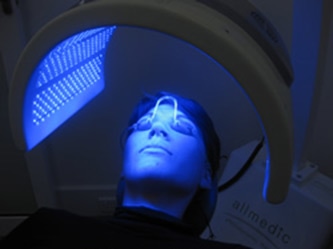
Once this photosensitizer is irradiated and activated by an appropriate light source, reactive oxygen species (“singlet Oxygen”) are produced which damage subcellular structures in the cells involved leading to their destruction (called phototoxic effect).
The photosensitizer most commonly used in dermatology is 5-aminolevulanic acid (5ALA).
When 5-ALA is applied to the skin it is absorbed faster by the more rapidly dividing, abnormal cells such as skin cancer and pre-malignant skin cells, keratoses, acne and rosacea lesions, bacteria within acne lesions, psoriasis, warts.
This leads to a larger and more rapid accumulation in these cells of the photosensitive substance Protoporphyrin IX. When this is irradiated by light of the correct wavelengths, it gives off the energy which results in the destruction of these abnormal cells.
Normal skin cells remain relatively unaffected.
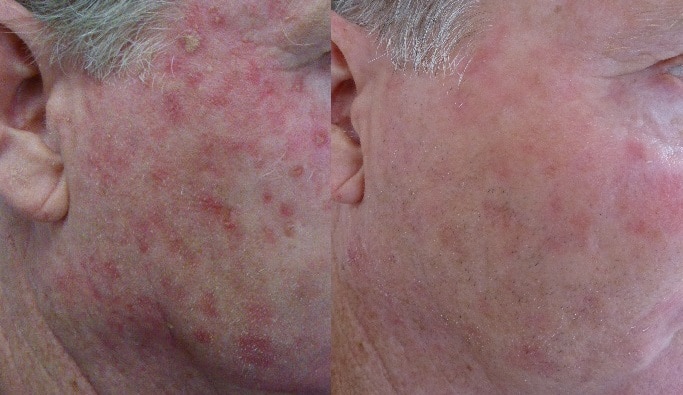
Before After
What is involved with PDT?
- The skin may need to be prepared or “primed” for 2 weeks pre-treatment with a keratolytic exfoliating cream to soften and lift the thicker surface lesions, which would otherwise block the applied light, and reduce efficacy.
- A Photosensitizer precursor (aminolaevulinic acid (ALA) is applied.
- A waiting period of a few hours is allowed to elapse, during which time.
- 5-ALA will be taken up by cells.
- 5-ALA will be converted by the cells to Protoporphyrin IX, the photosensitizer.
- The physician shines a bright red/blue light on the area to be treated. The light exposure lasts between 15 minutes and 30 minutes.
- Over the next few days, the exposed skin becomes red (like sunburn), then scaly and crusty as the damaged skin and lesions begin to peel off.
- In a few weeks, the treated area has healed, leaving healthy skin behind. For extensive malignancies or thick keratoses, repeat treatments may be required.
- After the treatment the patient will need to avoid excessive exposure to sunlight for approximately two days to prevent ongoing activation of the targeted skin.
Specificity of treatment is achieved in two ways. First, light is delivered only to tissues that a physician wishes to treat. In the absence of light, there is no activation of the photosensitizer and no cell damage in other areas.
Secondly, in the treated area, the 5-ALA is selectively absorbed at a greater rate by targeted cells which are the abnormal metabolically hyperactive or rapidly dividing malignant or pre-malignant cells.
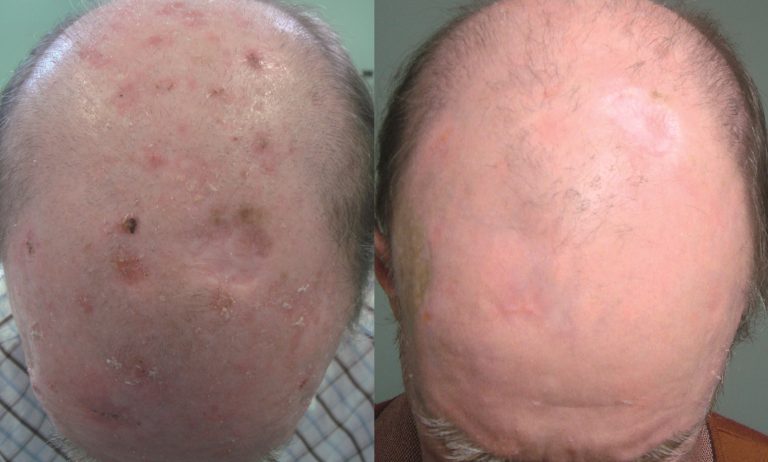
Before After
Side Effects of PDT with 5-ALA
- Sensation of tingling, itching or burning at the therapy site.
- Mild swelling and sensation of sunburn for two to three days after therapy.
- Crusting, scaling and peeling in the treatment area which may last for several days, but up to two weeks with severely damaged skin.
Treated lesions are sensitive to light. Therefore, people being treated will need to avoid sunlight and sources of bright light for at least 48 hours after 5-ALA is applied.
Medicines that contradict the use of 5-ALA / PDT include:
- Thiazides (used to treat high blood pressure)
- Tetracyclines, fluoroquinolones, griseofulvin, or sulphonamides (used to treat infection)
- Sulfonylureas (used to treat diabetes)
- Phenothiazines (used to treat serious emotional problems)
How many treatments are required?
Most people need only one or two treatments, however, depending on the amount of damage, and the thickness of the lesions, more treatments may be required.
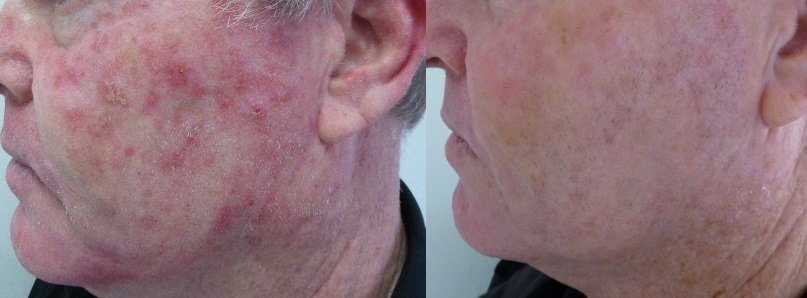
Before After
Light Source
For a photodynamic reaction to be effective, the light source must emit wavelengths which maximally activate the Protoporphyrin IX.
Direct Sunlight is a very effective activation, with exposure time from 10 to 30 minutes, depending on the weather that day.
Otherwise, a range of laser, LED and IPL light sources are equally effective.
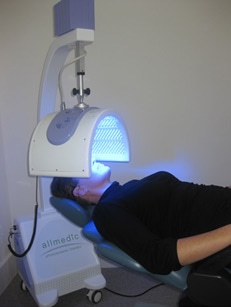
Medical and Cosmetic Applications
Photodynamic Therapy has been used very successfully for some years for the treatment of severely sun-damaged skin, where the damage is characterized by multiple skin cancers and widespread severe, thick crusting of solar (or actinic) keratoses.
More recently there have been very encouraging indications that PDT may be able to play an important new role in skin cancer prevention by destroying pre-cancerous lesions before they become visible as skin cancers. This is due to the fact that the pre-cancerous cells are already abnormally hyperactive and multiplying rapidly. Thus they are more susceptible to PDT and are able to be destroyed before they manifest as skin cancers.
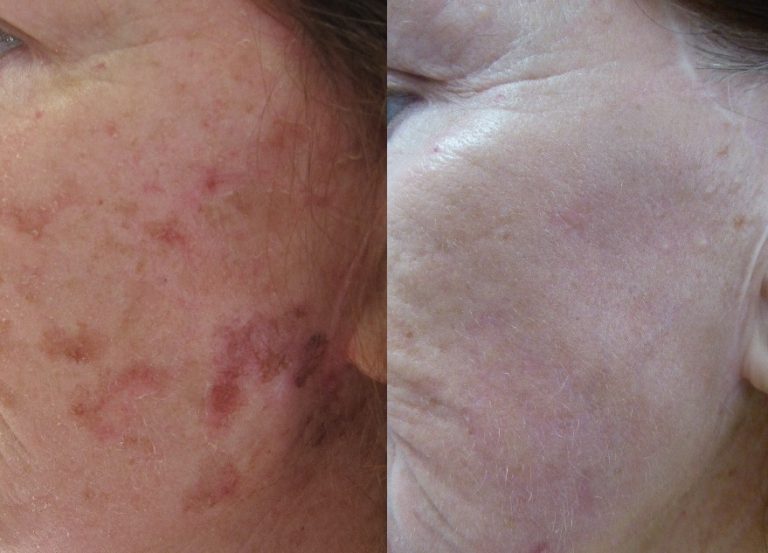
Before After
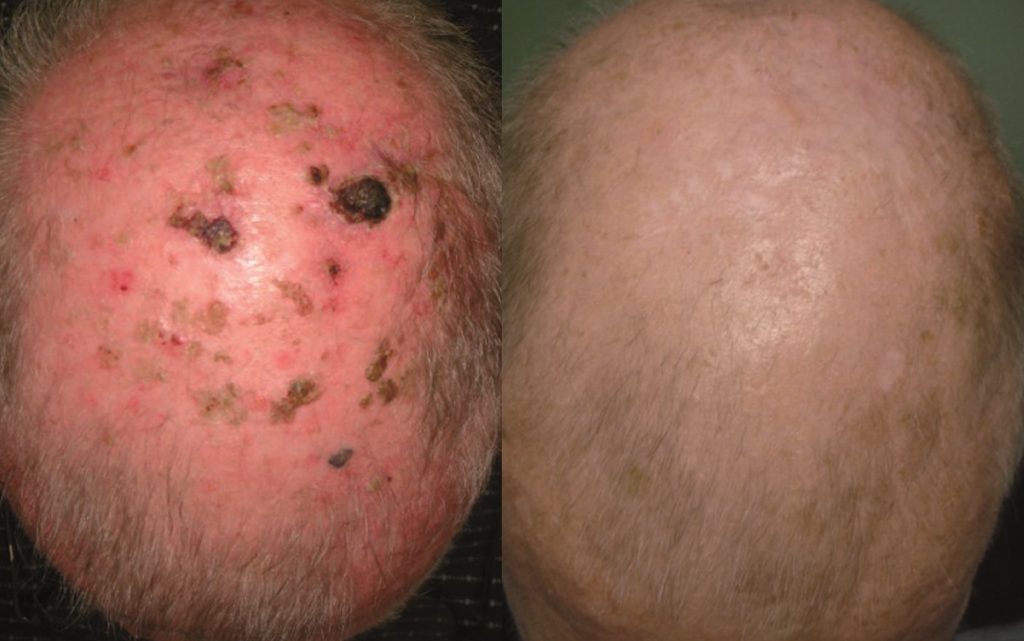
Before After
Cosmetic Applications
In the process of treating thousands of patients for severe sun damage and skin cancers, it was observed that PDT also resulted in a more generalised, marked improvement in a wide range of other, less severe but very common features of sun damaged skin. These include:
- Actinic keratoses (scaly dry sun-spots)
- Dyschromia (mottled hyperpigmentation / freckles)
- Fine wrinkling
- Uneven or damaged skin texture
These observations have led to the use of PDT for a range of cosmetic improvements to sun damaged and ageing skin (Photo-rejuvenation).
In addition to this, PDT is proving very effective for other cosmetic skin problems such as acne, rosacea, sebaceous gland hyperplasia, warts, psoriasis and seborrheic keratoses (senile warts).